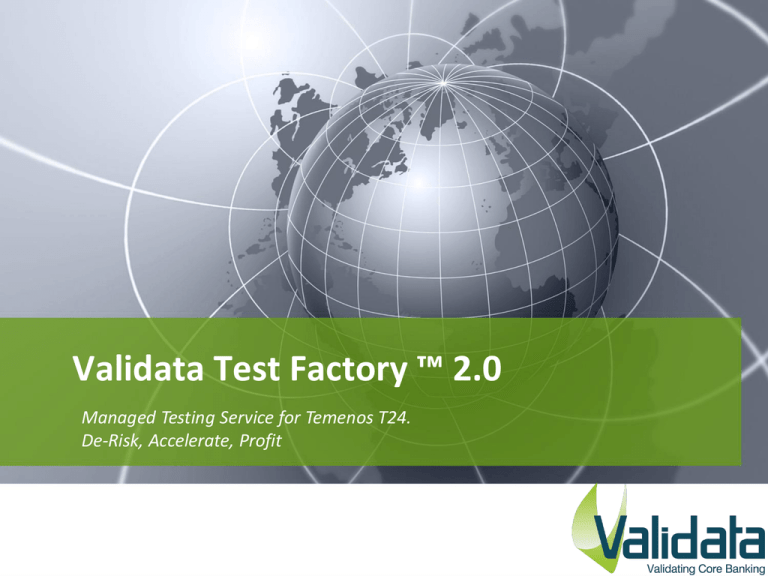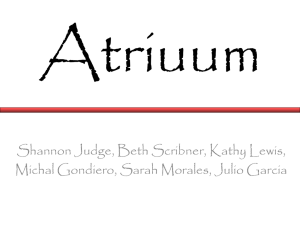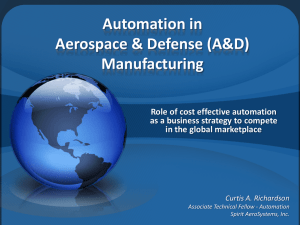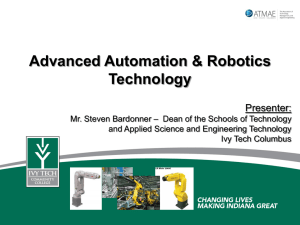PowerPoint Template
advertisement

Validata Test Factory ™ 2.0 Managed Testing Service for Temenos T24. De-Risk, Accelerate, Profit Agenda 1 Business Challenges 2 Validata Test Factory ™ 2.0 3 Validata Testing Approach 4 Validata Testing Methodology 5 Product Overview 6 Benefits Business Challenges All organizations are under pressure to reduce costs and improve quality, whilst keeping pace with new technologies and practices. Software-as-a-Service (SaaS) and Cloud are emerging to become the predominant business models and creating disruption in the testing tools market. The traditional focus has been to test same specific activities (load, stress, functional, regression). Economic conditions and pressure to improve time to market are placing increased emphasis on productivity and moving away from the shadow of shrink-wrapped software and towards the future of Cloud & SaaS models. With poor software quality leading to user dissatisfaction as well as increased development and maintenance costs, good quality assurance is an essential but costly process. Therefore, having a well-defined testing software tool and practices to drive software quality will positively affect the overall bottom line of the business. Validata Test Factory ™ 2.0 Unlike traditional tools, Validata SAS validates Core Banking systems, aligns testing to business requirements whilst improving productivity and automation coverage, and achieves reduced test cycle times in all phases of testing. Service offerings and flexible pricing schemes are all part of the unique offering of Test Factory™. Test Factory™ is a standardized Test ‘Utility’ model with welldefined best practices, test automation, re-usable test assets and standards, robust management processes for defects and change, and enhanced ROI. Test Factory 2.0 model enables customers to move away from unstable environments, limited centralized governance and high costs of quality, and establish their own test environment in the cloud leveraging prebuilt test cases and Validata SAS automated solution that can reduce test effort by a factor of as much as ten to one. The end of testing as you know it! Pay per use model (monthly, quarterly, annually, etc) Test Case Pricing, Release Base Pricing Effective dating of prices Instant testing from everywhere Low risk commitment Ease of use Instant access to pre-built content Test Factory ™ 2.0 Service Offerings Custom Reporting via SLA’s and defect management The only true Pay-per-use model for Temenos T24™. Optimize IT spending and reduce hardware and license costs. Shift from capital expenses (CAPEX) to operating expenses (OPEX) model to free capital for more strategic investments. Test Factory ™ 2.0 Delivery Phases Phase 1 – On Going Due Diligence Gap Analysis Test Quality Analysis Test Case Design Manual execution Phase 2 – Set Up Phase 3 – Run Impact Analysis Test Automation Environment preparation Dry Run New Test Case design New Test automation Environment preparation Run 3 Test cycles Phases 1 and 2 are one off Phase 3 is replicated for each type of testing (Functional, System, Integration etc.) taking advantage of reusable assets from previous phases and executions Test Factory™ 2. 0 Service Plans Test Factory™ 2.0 Workflow Automation Test Suite Process Flow Business Requirement Gathering Test Case estimation / Effort Estimation One Time Setup for any Project Validata Setup (Typical creation as per Version of T24 to be Tested) Define Project Map Resources Set Up Environment Select Adapters Requirement Definition Test case Creation Generate test cases Input Statistic Data Execution of Test Cases T24 Defect Management Link test cases via calculation Reusable for any Geographic release with minor modification T24 Model Bank Accelerators Access to a library of pre-built reusable test cases and business workflows, which enable you to jumpstart your testing projects and substantially reduce the effort of testing. These test cases are the foundation for end-to-end automated testing of the complete Temenos T24™ stack from Country Model Bank, to ISB and Local Code. Our testing accelerators allow Validata Test Factory™ 2.0 to jump start our clients implementation by having up to 80% of the core Test Cases and Test Steps available immediately testing begins. The structure provides a ‘ready-to-use’ set of test scenarios, grouped into logical functions and based on the major banking business functions (i.e. Loans, deposits, FX...), providing re-usability. Reusability is the key driver in reducing costs. As a limited amount of customization will be required, the cost of implementing Validata is significantly reduced. Extend your test coverage with Validata Test Factory ™ 2.0! Validata Adapters An Adapter is a component which connects Validata Test Factory ™ 2.0 to external systems and data sources to enable quality automated testing: Validata Test Factory ™2.0 acquires appropriate information from the software application under test using our unique adaptor technology SOA Adapter MS Project Adapter Our adapters enable the mapping between Validata objects and system under test objects No development / scripting is required T24 Web Adapter SQL Adapter Generic Adapters SWIFT Adapter Globus Desktop Adapter T24 OFS Adapter ISO-8583 Adapter Performance Adapter SOAP Adapter Benefits Consistent defined Quality for each Release Reduced defect leakage across the testing lifecycle Team optimization by utilizing shared services Predictable service delivery Business – IT aligned approach to testing Low risk commitment Effortlessly Scalable and Easy to Deploy Improved productivity and standardized processes Efficient reporting and metrics Reduced Total Cost of Ownership Up to 60% reduction in testing execution effort 40% reduction in knowledge transition effort The Critical Differences Higher system quality achievable trough structured operating model with predictable repeatable delivery process Better planning though more accurate effort estimation Rigorous metrics collection across projects supports continuous process improvement Resources Lower labor costs through optimization utilization of offshore resources Dedicated team builds expertise over time Reduced effort through reuse of common frameworks, templates and data repositories Maximized test automation Optimize tool licensing requirements Managed Test Center: Benefits Standard Processes Common Tools & Infrastructure Knowledge Repository Consolidated knowledge repository lowers risks associated with loss of institutional knowledge Ability to leverage crossproject understanding yields more complete testing Cost Effectiveness: Automated Testing 900 Manual Testing 800 Traditional Automation Aggregated Effort (hours) 700 Typically Three Test Cycles within Upgrade 600 500 400 Validata Automation Testing Suite (ATS) # of Test Cycles 300 200 1 2 3 Validata ATS ROI within 2 test cycles 4 5 6 7 Traditional Automation ROI within 6 test cycles 8 9 10 Total Effort Per Approach (Hours) (Assumption: 35 Business Processes) Effort Overview: Test Creation Phase Manual Systems Integration Testing Functional Testing Continuous Regression Testing Performance Testing -70% less effort by reusing the test artifacts from SIT -60% less effort by reusing the test artifacts from SIT -30% Faster on test case creation Limitations -60% Faster than manual No Low level testing. With Accelerators Lack of Knowledge and Complex test transactions and enquiries. Highest Automation Required: Enquires Advanced Enquiries Test Data Automatic Business Rules Comparison Rules No qualitative test cases. No reusability -40% Due to Test data and scenarios reusability Highest Automation Required: Enquires Advanced Enquiries Comparison Rules Automatic Business Rules Highest Automation Required: Automatic Business Rules Effort Overview: Test Execution Phase Manual Functional Testing Systems Integration Testing Continuous Regression Testing Performance Testing -60% Faster on every cycle -70% Faster in any cycle Cycle 1 Same Effort for all Cycles Cycle 2 Cycle 1 Cycle 2 Cycle 3 Cycle 3 Cycle 4 -80% Faster on every cycle Cycle 1 Cycle 2 Cycle 4 Cycle 3 No comparison to manual as it is only automatic ROI based on re-usability 60% Reusability 40% Reusability 0% Reusability % Reusability Run Test Factory Automation Design C O S T % Reusability Automation Design C O S T On boarding Test Case Creation $$ Infrastructure Infrastructure Test Case Creation Automation – RUN 1 $$ Run Test Factory Automation - RUN 2 % Reusability Run Test Factory Automation Design Test Case Creation Infrastructure Automation – RUN 3 C O S T $$ Do You Have Any Questions? We would be happy to help.








